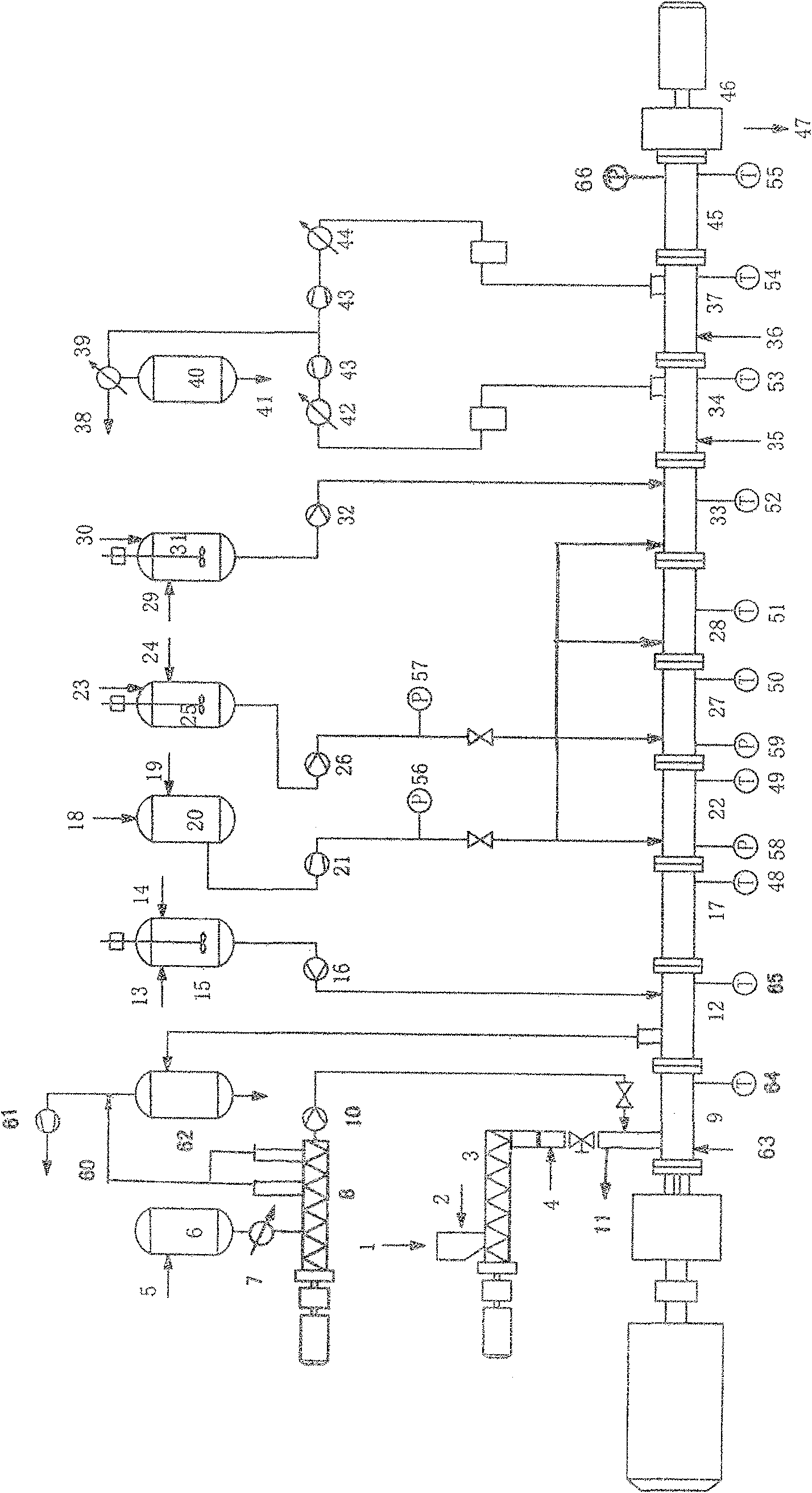Method of manufacturing halogenated rubber like polymer
A halogenated rubber and polymer technology, which is applied in the field of manufacturing halogenated rubber-like polymers, can solve the problems of prone to hydrolysis reaction, a large amount of salty wastewater and acidic waste gas, and high energy and material consumption
- Summary
- Abstract
- Description
- Claims
- Application Information
AI Technical Summary
Problems solved by technology
Method used
Image
Examples
Embodiment 1
[0064] use figure 1 As shown in the process flow, the main equipment of the closed drying system in this embodiment is a reverse twin-screw extruder unit (reactor), the screw diameter is Φ36mm, and the length-to-diameter ratio L / D=60, except that the metering and discharging section is meshing , and the rest of the segments are non-meshing. The cylinder body is divided into 10 sections for temperature control, the internal cooling medium of the cylinder is 0 ℃ white oil, and the outer cylinder is heated by an electric heating copper tile heating jacket. The raw material used is chopped solid butyl rubber fragments or strips, and its maximum outline dimension or cross-section is less than 20mm. Add the hopper of the spiral crushing plasticizer ③, the weight is 30kg, its specification is unsaturation 2%, Mooney 34 commercially available general-purpose butyl rubber. In the lower part of the hopper, nitrogen gas with a pressure of 0.01MPa is continuously injected, and the flow ...
Embodiment 2
[0067] The same reactor as in Example 1 was used to close the drying system. But the raw material used in this embodiment is butyl rubber hexane solution with a solid content of 18% (wt) pumped from ⑤, the unsaturation of the dry glue is 2.2%, and the Mooney viscosity is 50. The inside of the tank is under the protection of positive nitrogen pressure. The glue liquid flows out from the raw material buffer tank ⑥, is heated to 150℃~160℃ by the preheater ⑦, and enters the double-screw concentrator ⑧. The solvent and a small amount of water are evaporated and recovered. The viscous solution concentrated to a solid content of about 70% is sent into the halogenation reaction system by the booster pump ⑩. Double-helix concentrator⑧, is a double-helix asynchronous and synchronous concentration reactor with a diameter of Φ100 and L / D=10. Its jacket has a heating function to keep the polymer raw material at a higher temperature so as to enter the halogenation reaction for plasticizatio...
Embodiment 3
[0069] The closed dry system and screw crushing plasticizer ③ are exactly the same as in Example 1, but the length-to-diameter ratio L / D of the screw extrusion reactor is 66, and a halogenation reaction section at the end of a knot is added. The raw material is dicyclopentadiene-type EPDM rubber with an unsaturation of 2.1% and a Mooney viscosity of 75. The solid EPDM rubber is crushed into irregular blocks with a shape less than 20mm, and the frequency of 30kg is added to the feeding hopper of the screw crushing plasticizer ③ at a frequency of 90 minutes, and nitrogen gas is introduced from ② to remove the air brought in. After ③ crushing and preliminary plasticization, it becomes a small porous floc material, and dry nitrogen is continuously injected at ④ to reversely replace the air entrained by the material. Entering the plasticizing section ⑨ of the halogenation reactor, the material is heated and mixed with pure nitrogen, and the nitrogen containing water and oxygen is d...
PUM
| Property | Measurement | Unit |
|---|---|---|
| diameter | aaaaa | aaaaa |
| aspect ratio | aaaaa | aaaaa |
Abstract
Description
Claims
Application Information
 Login to View More
Login to View More - R&D
- Intellectual Property
- Life Sciences
- Materials
- Tech Scout
- Unparalleled Data Quality
- Higher Quality Content
- 60% Fewer Hallucinations
Browse by: Latest US Patents, China's latest patents, Technical Efficacy Thesaurus, Application Domain, Technology Topic, Popular Technical Reports.
© 2025 PatSnap. All rights reserved.Legal|Privacy policy|Modern Slavery Act Transparency Statement|Sitemap|About US| Contact US: help@patsnap.com

